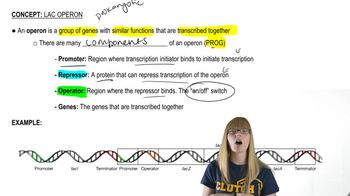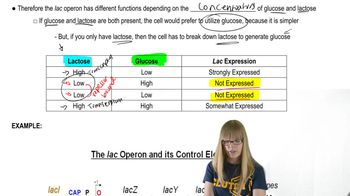Table of contents
- 1. Introduction to Genetics51m
- 2. Mendel's Laws of Inheritance3h 37m
- 3. Extensions to Mendelian Inheritance2h 41m
- 4. Genetic Mapping and Linkage2h 28m
- 5. Genetics of Bacteria and Viruses1h 21m
- 6. Chromosomal Variation1h 48m
- 7. DNA and Chromosome Structure56m
- 8. DNA Replication1h 10m
- 9. Mitosis and Meiosis1h 34m
- 10. Transcription1h 0m
- 11. Translation58m
- 12. Gene Regulation in Prokaryotes1h 19m
- 13. Gene Regulation in Eukaryotes44m
- 14. Genetic Control of Development44m
- 15. Genomes and Genomics1h 50m
- 16. Transposable Elements47m
- 17. Mutation, Repair, and Recombination1h 6m
- 18. Molecular Genetic Tools19m
- 19. Cancer Genetics29m
- 20. Quantitative Genetics1h 26m
- 21. Population Genetics50m
- 22. Evolutionary Genetics29m
12. Gene Regulation in Prokaryotes
Lac Operon
Problem 1a
Textbook Question
What are the advantages and disadvantages of using GFP versus lacZ as a reporter gene in mice, C. elegans, and Drosophila?
 Verified step by step guidance
Verified step by step guidance1
<b>Step 1:</b> Understand the role of reporter genes. Reporter genes are used to study gene expression and regulation by producing a detectable product. GFP (Green Fluorescent Protein) and lacZ (which encodes β-galactosidase) are common reporter genes.
<b>Step 2:</b> Consider the advantages of GFP. GFP is advantageous because it allows for real-time visualization of gene expression in living organisms without the need for additional substrates or staining. It is non-invasive and can be used in live imaging studies.
<b>Step 3:</b> Consider the disadvantages of GFP. GFP may require specific equipment for fluorescence detection, and its expression can sometimes interfere with normal cellular processes. Additionally, GFP fluorescence can be affected by environmental conditions such as pH and temperature.
<b>Step 4:</b> Consider the advantages of lacZ. The lacZ gene product, β-galactosidase, can be easily detected using colorimetric assays, which are simple and inexpensive. It is a well-established method with a long history of use in various organisms.
<b>Step 5:</b> Consider the disadvantages of lacZ. The detection of lacZ requires cell fixation and substrate addition, which means it cannot be used for live imaging. This can limit its use in dynamic studies of gene expression.
Recommended similar problem, with video answer:
 Verified Solution
Verified SolutionThis video solution was recommended by our tutors as helpful for the problem above
Video duration:
2mPlay a video:
Was this helpful?
Key Concepts
Here are the essential concepts you must grasp in order to answer the question correctly.
Reporter Genes
Reporter genes are genes that researchers use to study gene expression and regulation. They encode proteins that produce easily measurable signals, such as fluorescence or color change, allowing scientists to visualize and quantify gene activity in living organisms. Common reporter genes include GFP (Green Fluorescent Protein) and lacZ, which encodes the enzyme β-galactosidase.
Recommended video:
Guided course

Mapping Genes
GFP (Green Fluorescent Protein)
GFP is a protein that exhibits bright green fluorescence when exposed to ultraviolet or blue light. It is widely used as a reporter gene because it allows for real-time visualization of gene expression in live cells and organisms without the need for substrate addition. Its advantages include high sensitivity and the ability to track multiple genes simultaneously using different fluorescent proteins.
Recommended video:
Guided course

Proteins
lacZ (β-galactosidase)
The lacZ gene encodes the enzyme β-galactosidase, which can cleave specific substrates to produce a colorimetric change, typically blue in the presence of X-gal. While lacZ is useful for detecting gene expression in fixed tissues, it has limitations, such as requiring substrate addition and not being suitable for live imaging. Its advantages include a straightforward assay and historical significance in genetic studies.
Recommended video:
Guided course

Lac Operon Overview

 4:27m
4:27mWatch next
Master Lac Operon Overview with a bite sized video explanation from Kylia Goodner
Start learning


